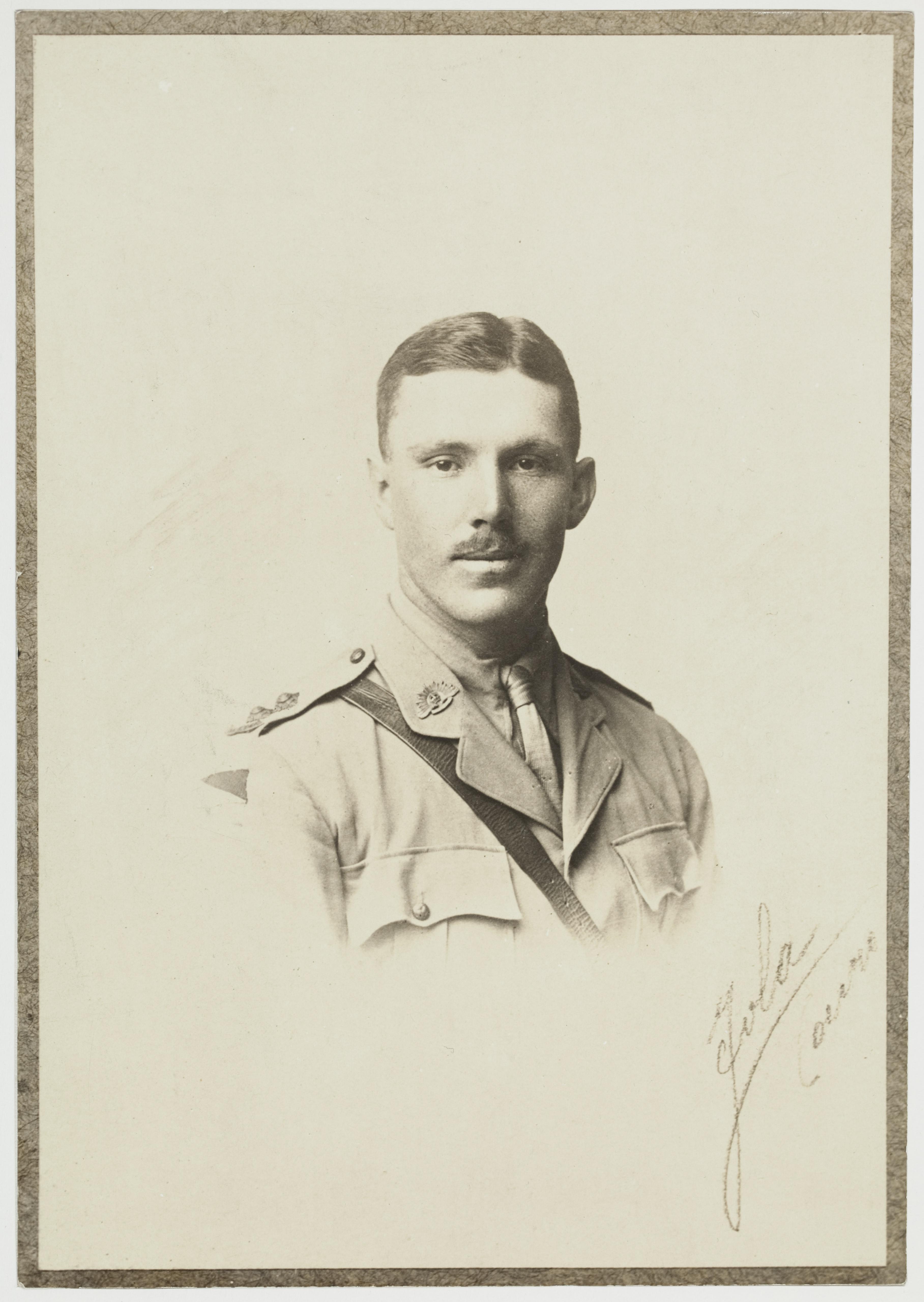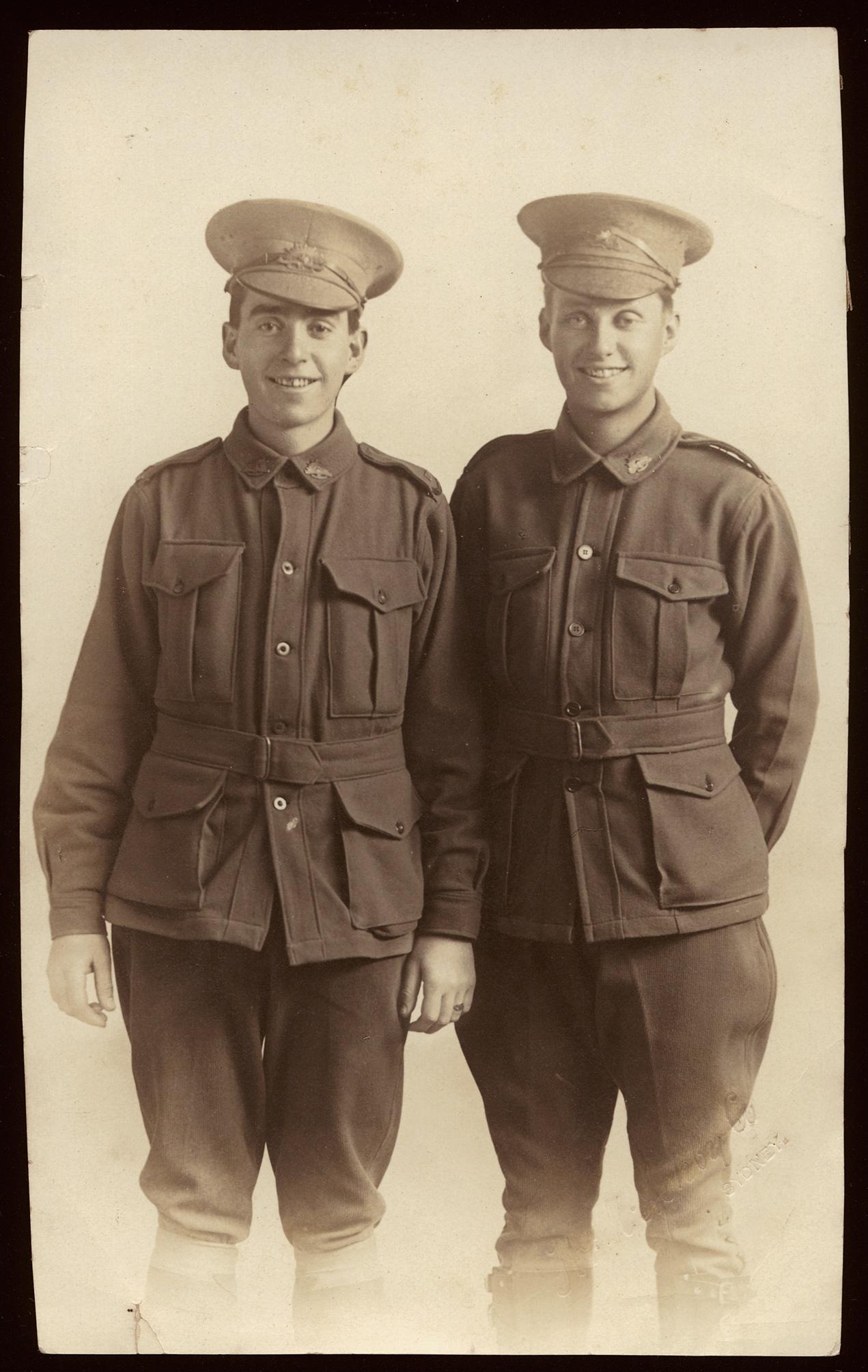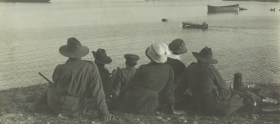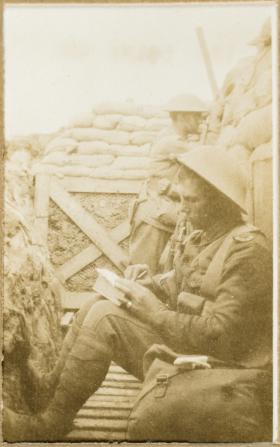Terence Ward Garling
Twenty year old Sydney man, Terence Ward Garling applied for a commission in the AIF in September 1914 and served with the Australian Field Artillery at Gallipoli, Egypt and France. He received a number of citations and promotions becoming one of the youngest officers in the AIF at the age of 22.
At the end of 1917, Terence was in England recovering from the effects of gas poisoning. He was ordered to return to France on 28th March, 1918. In his last letter home to his parents he wrote ominously that he, ‘was recalled to France yesterday on account of doings up the front.’
During a battle on the Somme at Dernancourt in April 1918, a shell splinter struck him in the left thigh while he was encouraging his men operating a battery of guns. He was evacuated to a field hospital, but died shortly afterwards.
Terence’s letter home, dated seven days before his death, was been annotated by his parents as ‘his last letter’. Following the letter are the bright pink telegrams that were sent to notify the family of the death of a soldier.
The Rev. Wilcoxson from the Greenwich Anglican church received these urgent telegrams requesting he notify Terence’s mother, Mrs Marie Garling of the death of her son. Priests and church ministers were often the bearers of sad news, notifying the next of kin of the death a family member in the War.
After the telegrams came many letters of condolence from Generals and officers and from the men who were part of Terence’s artillery brigade. These letters describe a brave, respected, caring young officer. A life which had so much potential had been cut short.
Remembering
Only one known body was returned home to Australia: Major-General Bridges. He was buried at the Royal Military College, Duntroon, in Canberra. Since most Australians were buried in cemeteries in the foreign fields where they died, or were buried at sea, there were no bodies to mourn over, no funerals and no wakes.
In 1916 the first statues of soldiers began appearing in Australian towns and the names of the fallen were engraved on monuments to the war dead. New traditions of public mourning were being formed around Anzac Day.
Bereaved families privately mourned loved ones who would never return. William and Marie Garling from Sydney created their own memorial to their son, Terence. His letters home, carefully bound together with photographs and memorabilia, were placed reverentially inside a wooden box with Terence’s initials and brigade colours decorating the front. They embossed the front of the book with the words, “In memoriam, Terence, 1914-1918”. This was their memorial to their youngest son who never came home.
Terence Garling represents all of those young men who held so much potential, who could have contributed much to society, if not stopped by premature death.
France, 14.4.18
Dear Uncle Willie
I have deferred writing about Terence till I had thoroughly satisfied myself that the report of his death in action was correct. Yesterday I went to his grave & added to its simple yet fitting embellishment my own offering, a token of my silent but deep sympathy for a grand young life, sadly cut off in its prime. But he did grand work, Uncle, & all, both his seniors & juniors, speak in just as high terms of him as an officer & a man as our his confreres speak of him. His ability was amply attested by his rank while yet a youth & so his life we cannot say was wasted …
with love
Your affectionate nephew
Gerald
Major Garling has served with me on many occasions both in Egypt & Gallipoli as well as in France. On every occasion & under all conditions he has proved himself an able soldier and an excellent officer. His cheerful courage, sustained & inspiring energy has at all times been an example to his brother officers & the men under his command. I have lost, in him, an experienced Battery Commander & an officer of proved ability, whose personality & service I cannot replace,
Brig. General Burgess, Commanding 4th
Aust. Div. Artillery, 14 April 1918
Dear Mrs Garling
Fergusson is my name, poor old Terry and I were the best of pals and fellow officers for a long time; so I am writing to you to give you my deepest sympathy. Terry was a son to be proud of, I can’t say enough for him, he was just about the bravest man I have ever known … His men loved him, his officers too.
He was always where the trouble was, in the shape of shelling, I mean. He was hit whilst walking up and down his battery which was being heavily shelled; giving confidence to his men; it was absolutely necessary too, as the enemy was attacking in overwhelming numbers and the batteries had to keep firing so long as there were men to man the guns; Terry as usual was doing his job properly as he always did; he was badly hit and was never properly conscious so did not leave any messages,
MA Fergusson, 7 April 1918
The Fry brothers: Alan & Dene
Well Mother, as you know your son was not only my brother but my very best friend.’
They were born two years apart and were best friends. They had grown up together in the Fry family home, Denegully in Lindfield, Sydney.
Alan, the younger brother, enlisted first in December 1914 at the age of 20. He had been working for the Burns Philp Shipping Company as a supercargo; managing cargo on merchant ships in the Pacific. Alan served in Egypt then arrived in France with the 13th Battalion, 10th Reinforcements in 1916. His service in France was brief. He died from wounds received at Pozieres on 14 August 1916.
Dene, who had enlisted at the age of 21 in May 1915 in the 3rd Battalion was stationed at a training camp in England when he received the news of his brother’s death. Dene sank into a depression, turning his sad thoughts over and over in his mind and admitted to his mother, ‘I am down’.
Dene was killed on 9 April 1917 at Hermies, near the town of Bapaume which had recently been taken by British troops when the German forces retreated to the Hindenburg Line in early 1917. Dene was one of the many casualties, shot in the head on Easter Monday morning as Allied forces took control over a series of French villages leading up to the Hindenburg Line.
Dene was initially buried in an isolated grave on the side of a track one mile west of the village of Hermies. His remains were later reinterred in the Beaumetz Cross Roads military cemetery near Bapaume in northern France.
Letter from Dene Home to his mother after having just heard of his brother's death.
Bovington Camp
West Camp A.I.F.
Dorset. Eng
17th Oct. 1916My Dear Mother
I am far too upset and sick at heart to say much Mother dear, for I have just had a telegram from Tommy which tells me Alan died of wounds in France on August fourteenth. I can find no one who knew him intimately round about and so I have to just think of him and turn my sad thoughts over and over in my own mind. Everyone is very sympathetic and some of the returned boys have said some fine things which only those who have been through this hell can say. But we are far from anywhere here and the very locality and weather are cold and cheerless, and I admit I’m down.Well Mother, as you know your son was not only my brother but my very best friend. I don’t know of anyone who could ever say one word against him
[Page 108]
2
and I’m sure he never made an enemy. The Burns Philp boys will be dreadfully sorry and all the north shore Line lads will I’m sure miss him. It leaves a great blank in my life which only little Bills growing up can fill. I hope Hazel and Dorothy fully realise what Alan has sacrificed and how they should cherish for ever all the kindest thoughts and remembrances of him, and remember that the greatest of all honours are his. "All the world might stand and say – This was a man." He had Uncle Fred’s nature but said as little of his own troubles as did Uncle Jim. Believe me Mother dear, the people in Australia are sadly ignorant of things. But it is best so. The privations of Egypt even, which are sneered at if a man has not been to the front, and which Alan had so much of, were hardly mentioned by him. We have 1000 wounded men here from the Posieres action and all agree that Gallipoli was a mere picnic. France is a battle of mammoth engines and until the people realise we must have men, it will go on[Page 109]
3
in the same equal way.Its awfully hard to write about Alan. I’m thinking hard of him all the time but your pen cant go fast enough for your thoughts. Tommy has written me a beautiful letter, but I feel oh so lonely through it all, so much on my own, and not an old pal who knew him near me. I could get so much off my chest if I could only chat over his memory with an old pal. I cannot simply cannot say more Mother, you must just all picture me of hope and joy and fortune destitute, and turning it over and over in my tired mind. Father will be ever so proud, and so he should be. He can hold his head as high as the highest, for he is the father of a hero who has done his bit in this crisis. How can the women have anything to do with the boys at home? If everyone would only come forward it would all be over & done with. Birdwood wants 40 000 Australians & he is going to take Lile.
[Page 110]
4
There are no soldiers like them. Anzacs especially these lame and sad faced lads all around us, are the pride of the empire. They have acquitted themselves magnificently and paid a cruel price. I feel proud beyond words of Alan just as proud as I felt when I knew dear little Marion was to be all mine.The question of whether I should go to the front now that Alan has gone must only be solved in one way Mother dear. I will go. Don’t worry over it you know I was born lucky. There is not much chance of us being moved over to France for months. I don’t think I will alter my mind, and even if I wanted it, I probably could not get a transfer. If conscription comes in it might make a difference. I will give it every consideration.
Give my best love to all at home. We have indeed suffered a sad sad thing in our happy home but it is a glorious thing. Goodbye Mother dear.
Your loving son
Dene
Elise Edmonds, Senior Curator, Research and Discovery
Collections
Fry family papers
Terence Ward Garling letters, 1914-1918, with related papers, 1918-1929, MLMSS 3432




